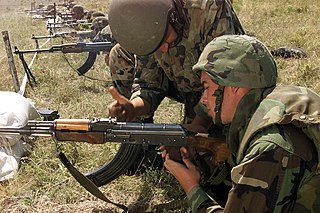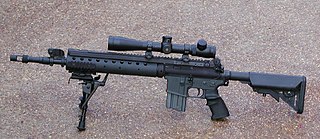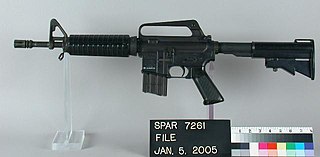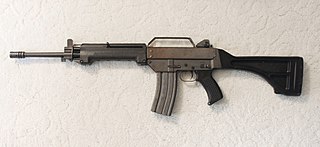
The M16 rifle is a family of military rifles adapted from the ArmaLite AR-15 rifle for the United States military. The original M16 rifle was a 5.56×45mm automatic rifle with a 20-round magazine.

A squad automatic weapon (SAW), also known as a section automatic weapon or light support weapon (LSW), is a man-portable automatic firearm attached to infantry squads or sections as a source of rapid direct firepower. Weapons fulfilling this role can be light machine guns, or modified selective-fire rifles fitted with a heavier barrel, bipod and a belt/drum-fed design.

The IMI Galil is a family of Israeli-made automatic rifles chambered for the 5.56×45mm NATO and 7.62×51mm NATO cartridges. Originally designed by Yisrael Galili and Yakov Lior in the late 1960s, the Galil was first produced by the state-owned Israel Military Industries and is now exported by the privatized Israel Weapon Industries.

The SA80 is a British family of 5.56×45mm NATO service weapons used by the British Army. The L85 Rifle variant has been the standard issue service rifle of the British Armed Forces since 1987, replacing the L1A1 Self-Loading Rifle. The prototypes were created in 1976, with production of the A1 variant starting in 1985 and ending in 1994. The A2 variant came to be as the result of a significant upgrade in the early 2000s by Heckler & Koch and remains in service as of 2023. The A3 variant was first issued in 2018 with several new improvements.

The Colt AR-15 is a lightweight, magazine-fed, gas-operated semi-automatic rifle. It is a semi-automatic version of the M16 rifle sold for the civilian and law enforcement markets in the United States. The AR in AR-15 stands for ArmaLite rifle, after the company that developed it in the 1950s. Colt's Manufacturing Company currently owns the AR-15 trademark, which is used exclusively for its line of semi-automatic AR-15 rifles.
The Colt Canada C7 and C8 are a Canadian family of service rifles, manufactured by Colt Canada, having similar design and function to the Colt M16A3.
The La France M16K is an M16 rifle modified by the company La France Specialties, which among with other firearm-related activities, convert common military weapons into more compact configurations typically for law enforcement and special forces use.

The FN Minimi is a Belgian 5.56mm light machine gun, also classified as a squad automatic weapon developed by Ernest Vervier for FN Herstal. Introduced in the late 1970s, it is in service in more than 75 countries. The weapon is manufactured at the FN facility in Herstal and their U.S. subsidiary FN Manufacturing LLC.

The United States Navy Mk 12 MOD 0/1/H Special Purpose Rifle (SPR) is a designated marksman rifle that was in service with United States Special Operations Forces in the designated marksman role until 2017, also designed to be shorter than standard weapons. SPR initially stood for Special Purpose Receiver as it referred to an add-on upper receiver assembly, but that nomenclature changed to Special Purpose Rifle as the weapon became a stand-alone weapons system.

The Colt Automatic Rifle-15 or CAR-15 is a family of M16 rifle–based firearms marketed by Colt in the 1960s and early 1970s. However, the term "CAR-15" is most commonly associated with the Colt Commando ; these select-fire carbines have ultrashort 10.5-inch (270 mm) and 11.5-inch (290 mm) barrels with over-sized flash suppressors.
The ArmaLite AR-18 is a gas-operated assault rifle chambered for 5.56×45mm NATO ammunition. The AR-18 was designed at ArmaLite in California by Arthur Miller, Eugene Stoner, George Sullivan, and Charles Dorchester in 1963 as an alternative to the Colt AR-15 design, a variant of which had just been selected by the U.S. military as the M16. A semi-automatic version known as the AR-180 was later produced for the civilian market. While the AR-18 was never adopted as the standard service rifle of any nation, its production license was sold to companies in Japan and the United Kingdom, and it is said to have influenced many later weapons such as the British SA80, the Singaporean SAR-80 and SR-88, the Belgian FN F2000, the Japanese Howa Type 89 and the German Heckler and Koch G36.

The Squad Advanced Marksman Rifle (SAM-R) is a semi-automatic designated marksman rifle developed and used by the United States Marine Corps. It gave users the capability to provide fire in support of a rifle squad, providing precision fire in support of an assault, and aid in observation and adjusting of supporting arms.

The Stoner 63 is a 5.56×45mm NATO modular weapon system. Using a variety of modular components, it can be configured as an assault rifle, carbine, top-fed light machine gun, belt-fed squad automatic weapon, or as a vehicle mounted weapon. Also known as the M63, XM22, XM23, XM207 or the Mk 23 Mod 0 machine gun, it was designed by Eugene Stoner in the early 1960s. Cadillac Gage was the primary manufacturer of the Stoner 63 during its history. The Stoner 63 saw very limited combat use by United States forces during the Vietnam War. A few were also sold to law enforcement agencies.
The Z-M LR-300 is an American select-fire assault rifle designed by gunsmith Allan Zitta and manufactured by Z-M Weapons. The model name LR-300 stands for Light Rifle and 300 is for 300 meters, which is regarded by the manufacturer as the effective range of the rifle with a standard 55 gr (3.6 g) FMJ bullet. The design is based on the AR-15, M16 and C7 rifles, but has a unique semi-direct gas impingement system and a folding stock option.

The two most common assault rifles in the world are the Soviet AK-47 and the American M16. These Cold War-era rifles have been used in conflicts both large and small since the 1960s. They are used by military, police, security forces, revolutionaries, terrorists, criminals, and civilians alike and will most likely continue to be used for decades to come. As a result, they have been the subject of countless comparisons and endless debate.

The Leader T2 MK5 Series firearms were chambered for the 5.56×45mm NATO cartridge and manufactured by Leader Dynamics of Smithfield, NSW, Australia (1978-1982/1983). The Leader was the brainchild of British weapons designer Charles St. George. It was originally a contender for a 5.56 mm Australian military service rifle to replace the then-issued Lithgow L1A1 SLR and Colt M16A1 rifles. What was unique about this endeavor was that Australia had never designed or manufactured its own commercial gas-operated semi-automatic rifle. The rifle was abandoned when the Steyr AUG was adopted for use by the Australian military.

The Barrett REC7 is an American firearm manufactured as a selective-fire fully-automatic and semi-automatic rifle by Barrett Firearms. It is an M4 carbine utilizing a short-stroke gas piston system. REC7 is available in either 5.56×45mm NATO or 6.8mm Remington SPC. The REC7 is Barrett's second AR-pattern rifle chambered for the 6.8mm Remington SPC cartridge, the first being the Barrett M468 rifle. The 6.8 SPC-chambered M468 rifle employed the same direct gas-impingement system as the M4.
The Colt Machine Gun or CMG was an open bolt belt-fed machine gun that fires 5.56×45mm cartridges designed by Colt Manufacturing Company in 1965. Colt hastily developed the CMG-1 to complement the CAR-15, a Colt branding of the M16 rifle, so that Colt might offer both of them as an alternative to the Stoner 63 weapons system. It failed to achieve any sales, and was replaced by the Colt CMG-2, which also failed to achieve any sales. The CMG-3 was a 7.62×51mm NATO version that failed as well.

An AR-15–style rifle is a lightweight semi-automatic rifle based on or similar to the Colt AR-15 design. The Colt model removed the selective fire feature of its predecessor, the original ArmaLite AR-15, itself a scaled-down derivative of the AR-10 design by Eugene Stoner. It is closely related to the military M16 rifle.



















